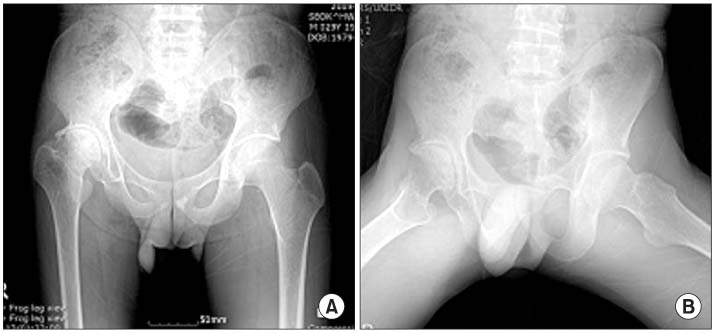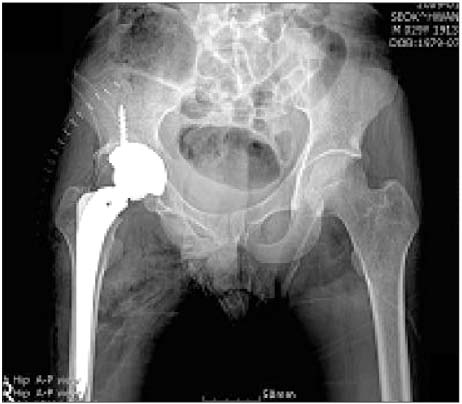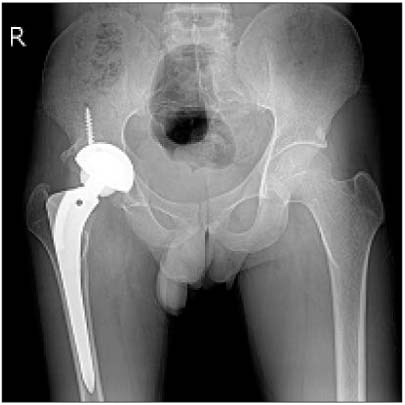J Korean Orthop Assoc.
2010 Aug;45(4):326-329.
Osteoarthritis of Hip in a Hypogammaglobulinemia Patient
- Affiliations
-
- 1Department of Orthopedic Surgery, Busan Paik Hospital, Inje University College of Medicine, Busan, Korea. kimjh8142@hanmail.net
Abstract
- Hypoglobulinemia is characterized by functional or quantitative abnormalities of one or more components of the immune system. It is typically manifests as recurrent infections that usually start in childhood. These recurrent infections cause various clinical symptoms. Infectious or aseptic arthritis can develop, and especially in bone and joint abnormalities. No case of arthritis in a patients with hypogammaglobulinemia has been reported, so we report on the management of osteoarthritis of the hip in a hypogammaglobulinemia patient.
Keyword
Figure
Reference
-
1. Sordet C, Cantagrel A, Schaeverbeke T, Sibilia J. Bone and joint disease associated with primary immune deficiencies. Joint Bone Spine. 2005. 72:503–514.
Article2. Furst DE. Serum immunoglobulins and risk of infection: how low can you go? Semin Arthritis Rheum. 2008. Epub 2008 Jul 11.
Article3. Lee AH, Levinson AI, Schumacher HR Jr. Hypogammaglobulinemia and rheumatic disease. Semin Arthritis Rheum. 1993. 22:252–264.
Article4. Chapel H, Geha R, Rosen F. IUIS PID (Primary Immunodeficiencies) Classification committee. Primary immunodeficiency diseases: an update. Clin Exp Immunol. 2003. 132:9–15.5. Simonte SJ, Cunningham-Rundles C. Update on primary immunodeficiency: defects of lymphocytes. Clin Immunol. 2003. 109:109–118.
Article6. Furr PM, Taylor-Robinson D, Webester AD. Mycoplasmas and ureaplasmas in patients with hypogammaglobulinaemia and their role in arthritis: microbiological observations over twenty years. Ann Rheum Dis. 1994. 53:183–187.
Article7. Hansel TT, Haeny MR, Thompson RA. Primary hypogammaglobulinemia and arthritis. Br Med J (Clin Res Ed). 1987. 295:174–175.8. Sany J, Jorgensen CH, Anaya JM, et al. Arthritis associated with primary agammaglobulinemia: new clues to its immunopathology. Clin Exp Rheumatol. 1993. 11:65–69.9. Chin T, editor. Agammaglobulinemia. 2006. http://www.emedicine.com/ped/topic54.htm.10. Webster AD, Loewi G, Dourmashkin RD, Golding DN, Ward DJ, Asherson GL. Polyarthritis in adults with hypogammaglobulinemia and its rapid response to immunoglobulin treatment. Br Med J. 1976. 1:1314–1316.
- Full Text Links
- Actions
-
Cited
- CITED
-
- Close
- Share
- Similar articles
-
- Hip Arthrodesis to Treat Severe Hip Osteoarthritis in an Adolescent with Down Syndrome
- Rapid Destruction of the Hip Joint Accompanied by an Enlarged Iliopsoas Bursa in a Healthy Man
- Arthroscopic Treatment of Subchondral Bony Cyst in Early Osteoarthritis of the Hip Joint Using Allogeneic Bone Graft: A Report of Two Cases
- Changes of the hip joints associated with chronic subluxation and dislocation: CT and plain radiographic analysis
- Unusual Cause of Hip Pain: Intrusion of the Acetabular Labrum





